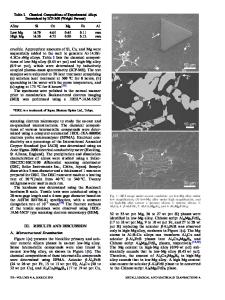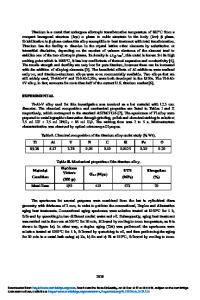Effects of Ge on Microstructure, Spreadability, and Mechanical Properties of the Sn-32Pb-18Cd Solder Alloy
- PDF / 2,500,046 Bytes
- 8 Pages / 593.972 x 792 pts Page_size
- 67 Downloads / 346 Views
JMEPEG (2020) 29:4541–4548 https://doi.org/10.1007/s11665-020-04958-9
Effects of Ge on Microstructure, Spreadability, and Mechanical Properties of the Sn-32Pb-18Cd Solder Alloy Kangli Li, Jian Lin, Tongju Wang, Yongping Lei, and Hanguang Fu (Submitted November 27, 2019; in revised form June 19, 2020; published online July 16, 2020) In this paper, the effects of xGe (x = 0, 0.002, 0.005, 0.01%) on the melting point, spreadability, wettability, microstructure, and mechanical properties of Sn-32Pb-18Cd solder alloys were investigated. The experiment results showed that the addition of Ge could increase the spreading area and wetting properties. The microstructures of solder alloy after reflowing were mainly composed of Pb phase and b-Sn phases, and the Cd element was distributed in the matrix. The addition of Ge could enhance the tensile strength and ductility. When the Ge content was equal to 0.005%, the maximum elongation reached 53.70%. Keywords
germanium, mechanical properties, microstructure, Sn-32Pb-18Cd solder alloy, spreadability
1. Introduction The restriction of hazardous substances (RoHS) rule bans the use of Pb and Cd in consumer electronics; however, leadbased solder alloys with excellent thermo-mechanical properties still have application prospects, such as in the aerospace field. With the miniaturization of electronic components and the development of a multi-step assembly process, low melting point solder alloys are necessary for temperature-sensitive devices and could reduce heat damage to the printed circuit board and electronic components. The most common leadbased eutectic solder alloy (Sn-37Pb) possesses excellent reliability, ductility, and wettability, but the Sn-37Pb melting point of 183 °C is higher than that of common multi-step assembly solder alloys like In- and Bi-based solders. The Sn32Pb-18Cd solder alloy with a lower melting point and higher tensile strength at room temperature is more suitable than Sn37Pb solder for the multi-step assembly process and thermal sensitive components (Ref 1-5). However, the spreadability and comprehensive mechanical properties of Sn-32Pb-18Cd must be improved to meet the requirements. Many recent studies have found an affordable and feasible method to improve the comprehensive properties of solder alloys by adding trace elements (Ref 6-9). Cu, Re, Zn, or other elements were used to improve the comprehensive properties of solder alloys. Shen et al. (Ref 10) reported that the addition of Cu to Sn-Bi could increase the tensile strength because of fine grain and precipitation strengthening. Dong et al. (Ref 11) showed that the shear strength of the Sn-Bi solder joint was
Kangli Li, Jian Lin, Tongju Wang, Yongping Lei, and Hanguang Fu, School of Materials Science and Engineering, Beijing University of Technology, Beijing 100124, PeopleÕs Republic of China. Contact e-mail: [email protected].
Journal of Materials Engineering and Performance
improved by the addition of Re, because Re refined and suppressed the coarsening of the Sn-Bi structure after aging. Zhou
Data Loading...











